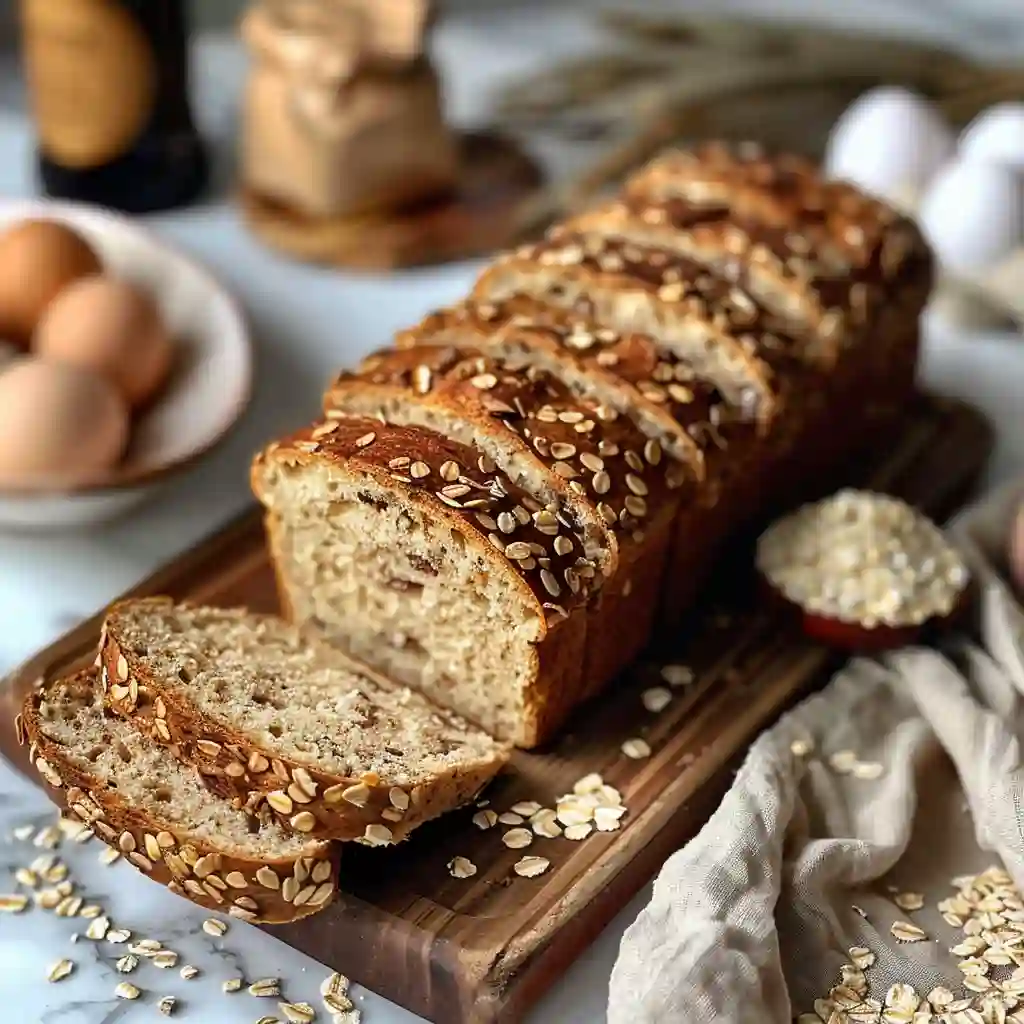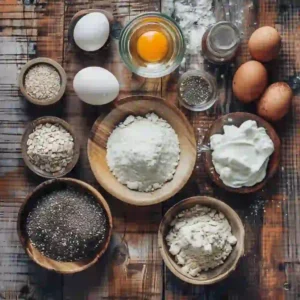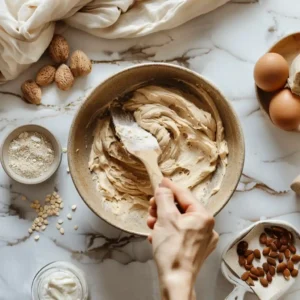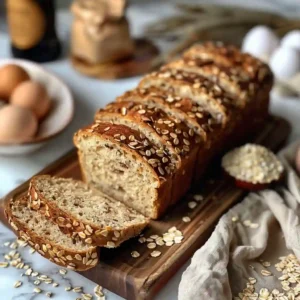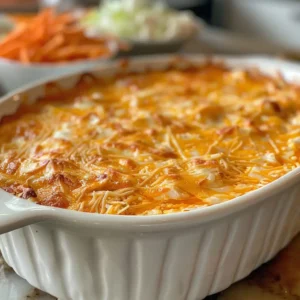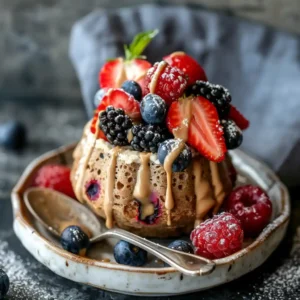As a busy dad always hunting for easy and nourishing meals, I used to think bread was the enemy—carbs galore, no substance. But that changed the moment I discovered high protein bread. It’s no longer just a trend; it’s a game-changer in how we approach breakfast, sandwiches, and even snacks.
High protein bread is exactly what it sounds like: bread that packs a powerful protein punch without compromising flavor or texture. Whether you’re buying from the store or baking your own, this guide will walk you through everything—the best brands, essential ingredients, baking tips, and creative recipes.
Don’t miss our high protein tater tot casserole if you’re craving another protein-packed favorite!
Table of Contents
High protein bread is a type of bread that contains 5g or more protein per slice, often enhanced with ingredients like whey, pea protein, or seeds. It supports satiety, muscle maintenance, and balanced blood sugar.
PART 1: Why High Protein Bread Matters for Today’s Diets
What Makes Bread “High Protein”?
High protein bread typically contains twice as much protein as traditional bread, often through added ingredients like:
- Whey protein isolate
- Pea or soy protein
- Egg whites
- Seeds and legumes (like quinoa, lentils, chia)
To qualify as “high protein,” a slice should provide at least 5 grams of protein, ideally more. Some breads use a mix of sprouted grains and added protein powders for a more complete amino acid profile.
Here’s a quick glance at how different types compare:
| Bread Type | Protein (per slice) |
|---|---|
| White Bread | 2–3g |
| Whole Wheat | 4g |
| Dave’s Killer Powerseed | 5g |
| Homemade Protein Bread | 8–12g |
Health Benefits of Choosing Protein-Rich Bread
From my experience switching to high protein bread, here’s what I’ve noticed—and what others love too:
- Better Satiety
Protein keeps you fuller longer, which means you won’t be ravenous an hour after breakfast. - Supports Muscle Health
Whether you’re an athlete or just trying to avoid muscle loss, especially as we age, protein-rich food choices throughout the day help maintain lean muscle. - Balanced Macros
High protein bread balances out carbs, which can help stabilize blood sugar—a win if you’re watching your glucose levels or managing insulin sensitivity. - Easy to Fit into Any Diet
Whether you’re keto, paleo, or just trying to eat more whole foods, there’s likely a high protein version of bread that fits your needs.
Learn more about low histamine bread if you’re following a gut-friendly or anti-inflammatory lifestyle.
PART 2: Understanding Protein Sources in Bread
Animal-Based vs Plant-Based Protein Ingredients
When it comes to boosting protein in bread, not all ingredients are created equal. You’ll usually find two broad categories: animal-based proteins and plant-based proteins.
Animal-Based Additions:
- Whey Protein Isolate or Concentrate – A complete protein from dairy, perfect for baking but can make the texture chewy if overused.
- Egg Whites – Help bind the dough and add structure, great for homemade versions.
These are ideal if you’re not dairy-sensitive and want the highest-quality protein with all essential amino acids.
Plant-Based Alternatives:
- Pea Protein – Mild in flavor and rich in lysine, often used in vegan bread.
- Soy Protein Isolate – Another complete plant protein, often used in gluten-free loaves.
- Hemp, Chia, Flax Seeds – These offer bonus fiber and healthy fats along with moderate protein.
If you follow a plant-based or dairy-free diet, stick with these options. Some of the most impressive high-protein vegan breads use combinations of sprouted grains and legumes to build a complete protein profile.
Looking for inspiration? Try our ayurvedic high protein recipes—many of them are dairy-free and rich in functional plant-based proteins.
Common Add-ins: Whey, Pea Protein, Seeds, and More
Let’s break down the most common ingredients found in protein-rich bread (store-bought or homemade):
| Ingredient | Benefits | Notes |
|---|---|---|
| Whey Protein | High bioavailability, neutral taste | May affect texture if overused |
| Pea Protein | Vegan, allergy-friendly | Slight earthy flavor |
| Pumpkin Seeds | Adds crunch and 7g protein per ounce | Best when toasted in dough |
| Chia & Flax Seeds | High in omega-3s, fiber, and moderate protein | Help bind dough naturally |
| Almond Flour | Low-carb, high-protein | Great for gluten-free recipes |
| Greek Yogurt | Moisture + protein | Perfect for soft sandwich bread |
My go-to for homemade bread? A blend of almond flour, chia seeds, and a scoop of unflavored pea protein. It gives just enough rise and keeps my kids happy too.
Check out our kodiak cakes cottage cheese hack for another creative way to sneak in protein using a blend of real food ingredients.
PART 3: Best High Protein Bread Brands to Buy in 2025
Top-Rated Store Brands (Dave’s Killer, Ezekiel, Base Culture)
When life gets busy, making your own bread isn’t always realistic. That’s why I keep a shortlist of reliable, high-protein bread brands I can grab at the store without hesitation. Here are the top-rated options for 2025 that I’ve tested—and actually liked:
🥇 Dave’s Killer Bread – Powerseed & 21 Whole Grains
- Protein per slice: 5–6g
- Why I love it: Nutty texture, great for toast or sandwiches. Organic, non-GMO, and packed with whole grains.
- Powerseed vs. 21 Whole Grains: Powerseed has more plant-based protein from seeds.
🥈 Ezekiel 4:9 Sprouted Grain Bread
- Protein per slice: 5g
- Why it’s a classic: Made with sprouted lentils, barley, and soybeans—creating a complete protein naturally.
- Pro tip: Toast it—it’s pretty dense, but worth it once crisp.
🥉 Base Culture Keto Bread
- Protein per slice: 6g
- Why it’s trending: Grain-free, dairy-free, and gluten-free. Made with almond butter and golden flax.
⭐ Other Notables
- Silver Hills Bakery – Squirrelly Bread has 6g protein and sprouted grains.
- Carbonaut – 7g protein, keto-approved with soft sandwich texture.
- Oroweat Protein Bread – More affordable, with 8g protein per slice (contains whey).
Check out our high protein birria ramen recipe for another surprising, protein-loaded meal idea. I used Ezekiel bread crumbs in the broth—it added real texture and stayed true to the high protein mission.
What to Look for on Nutrition Labels
When shopping for high-protein bread, here’s what I personally check every time:
| Label Feature | What to Look For |
|---|---|
| Protein | 5g or more per slice is ideal |
| Ingredients List | Look for whole grains, seeds, or added protein (whey, pea) |
| Carbs & Fiber | Try to keep net carbs under 15g if watching sugar levels |
| Additives | Avoid breads with too many preservatives or sugars |
| Diet Compatibility | Gluten-free, keto, or vegan depending on your needs |
Not every “high protein” label tells the full story. Some brands add soy flour or isolate without fiber or quality ingredients. I always recommend reading the full label, not just the headline.
Don’t miss our roundup on monster cookie protein balls—they pair wonderfully with high-protein toast for a full post-workout meal!
PART 4: High Protein Bread for Special Diets
Low-Carb & Keto-Friendly Options
When I was testing blood sugar swings after meals, traditional bread just didn’t work for me. That’s when I turned to low-carb and keto high protein bread options that helped me feel full without the crash.
Here are some of my top picks and tips:
🥑 Keto-Friendly Breads
- Base Culture Keto Bread: Only 4g net carbs, made from almonds, flax, and eggs.
- Carbonaut Low-Carb Bread: 7g protein, just 2g net carbs.
- Homemade Almond Flour Bread: Add unflavored whey protein to almond flour, eggs, baking soda, and olive oil for a fluffy, keto loaf.
Most keto breads use nut-based flours or egg-white heavy bases for structure. They don’t rise much but toast well.
Looking for more creative keto ideas? Don’t miss our keto pumpkin muffins—they make a satisfying high-protein snack.
Gluten-Free, Diabetic, and Low Histamine Breads
If you deal with food sensitivities like I do (especially during stress flare-ups), the wrong bread can trigger fatigue, bloating, or worse. That’s why I’ve explored high protein breads that fit gluten-free, diabetic-friendly, and low histamine diets.
🌾 Gluten-Free Options
- Made with almond flour, coconut flour, or cassava
- Use chia or flax seeds as binders instead of gluten
Some brands like Uprising Bread offer 6g protein and are free of grains, using psyllium husk and flax instead.
🩺 Diabetic-Friendly
- Choose breads with a high fiber-to-carb ratio
- Look for “net carbs” under 15g
- Avoid added sugars and maltodextrin
Whole grain sprouted breads like Ezekiel are ideal because they digest slower and contain plant protein + fiber.
Curious about gut-sensitive bread? I highly recommend checking out our low histamine bread, which helped me during a hormone reset period.
PART 5: How to Make High Protein Bread at Home
Key Ingredients You’ll Need
When I first started baking my own high protein bread, I wanted something soft enough for my kids but still packed enough protein to fuel my workouts. After a dozen test batches, here’s what I found works best:
🧾 Protein Boosters
- Unflavored whey protein isolate – Best for fluffy texture
- Pea protein powder – Great plant-based option
- Greek yogurt or cottage cheese – Adds moisture and creaminess
🌾 Base Ingredients
- Almond flour or oat flour – Naturally higher in protein than all-purpose
- Eggs or egg whites – Adds structure and extra protein
- Chia or flax seeds – Helps bind ingredients, adds fiber
🧂 Flavor & Function Add-ins
- Baking powder or baking soda for lift
- Apple cider vinegar for tang and rising power
- Salt, herbs, garlic powder, or nutritional yeast for savory blends
Want to go all in? Check out our mounjaro-friendly protein-packed lunch for pairing inspiration—this bread makes a killer sandwich base.
Kitchen Tools and Baking Tips for Best Texture
You don’t need fancy gadgets to make protein bread at home. I started with a whisk, a mixing bowl, and a loaf pan—and you can too.
🔪 Tools I Use
- Mixing bowl
- Rubber spatula or wooden spoon
- 9×5-inch loaf pan (nonstick or parchment-lined)
- Cooling rack
👨🍳 Mark’s Home-Baked Tips
- Don’t overmix – Especially with whey, overmixing creates a dense loaf.
- Let the batter rest – Chia and flax need a few minutes to absorb moisture.
- Bake low and slow – I use 325°F for 35–45 mins depending on ingredients.
- Use foil for top – If the crust browns too fast, tent with foil halfway through.
- Cool fully before slicing – Seriously, this makes all the difference in texture.
And if you’re feeling experimental? Don’t miss our high protein cottage cheese pizza crust. It’s one of the easiest beginner-friendly bread bases I’ve tried—and the protein content is next-level.
Print
High Protein Bread: Best Brands, Recipes, and How to Make It at Home
Soft enough for kids, packed with protein for gains—this homemade high protein bread is the perfect balance of texture and nutrition.
- Total Time: 50 minutes
- Yield: 1 loaf (10 slices)
Ingredients
- 1/2 cup unflavored whey protein isolate
- 1/2 cup pea protein powder (for plant-based option)
- 1/2 cup Greek yogurt or cottage cheese
- 1 cup almond flour or oat flour
- 4 eggs or 6 egg whites
- 2 tbsp chia or flax seeds
- 1 tbsp baking powder or 1/2 tsp baking soda
- 1 tsp apple cider vinegar
- 1/2 tsp salt
- Optional: 1 tsp garlic powder, dried herbs, or nutritional yeast
Instructions
- Preheat oven to 325°F (163°C).
- In a mixing bowl, combine protein powders, flour, baking powder/soda, salt, and any dry seasonings.
- Whisk in eggs or egg whites, Greek yogurt or cottage cheese, and apple cider vinegar.
- Add chia or flax seeds and let the batter rest for 5 minutes to thicken.
- Pour batter into a 9×5-inch loaf pan lined with parchment or nonstick sprayed.
- Smooth the top with a spatula.
- Bake for 35–45 minutes, checking doneness with a toothpick.
- If the top browns too quickly, tent with foil halfway through baking.
- Remove from oven and let the bread cool completely on a rack before slicing.
Notes
Don’t overmix the batter—especially with whey protein—to avoid a dense loaf. Resting the batter helps seeds absorb moisture for better structure.
- Prep Time: 10 minutes
- Cook Time: 40 minutes
- Category: Bread
- Method: Baking
- Cuisine: American
PART 6: Creative High Protein Bread Recipes
Savory Recipes: Sandwiches, Toasts, and Melts
High protein bread doesn’t just belong on the side of your plate—it deserves to be the main event. Once I nailed my go-to loaf, I started using it in everything from lunches to weeknight dinners. Here are some of my favorite ways to put it to work:
🥪 Savory Ideas to Try:
- Turkey Avocado Power Sandwich
Stack lean turkey, mashed avocado, and sprouts on toasted protein bread. - Hummus + Roasted Veggie Toast
A plant-based favorite topped with grilled zucchini, eggplant, and hummus. - Egg & Spinach Breakfast Melt
Use a toaster oven to melt cheese over egg and spinach on a thick slice. - Buffalo Chicken Dip Bread Boat
Slice a loaf in half, hollow it slightly, and fill with our high protein buffalo chicken dip. Toast it until bubbly. Game changer.
If you’ve got leftover bread, cube it for croutons, air fry them, and you’ve got protein-rich salad toppers in minutes.
Sweet Uses: Protein French Toast, Bread Pudding, and More
I used to think sweet and high protein didn’t mix—but one bite of protein French toast changed that. Whether you’re baking a weekend treat or just need a quick breakfast, these ideas are worth bookmarking:
🍞 Sweet Protein-Packed Recipes:
- Cinnamon Protein French Toast
Whisk eggs, vanilla, cinnamon, and a scoop of protein powder. Soak slices and pan-fry.
→ Try our high protein French toast recipe for a cozy weekend brunch. - Chocolate Banana Bread Pudding
Mix chopped protein bread with mashed banana, cocoa powder, eggs, almond milk, and bake in a dish. Great warm or cold. - Peanut Butter & Berry Toast
Smear PB on toasted bread, add fresh raspberries, and drizzle with honey or agave. - Protein Dessert Sandwiches
Use cottage cheese and protein-packed chocolate mousse between slices. Freeze and slice into mini bars.
→ Don’t miss our cottage cheese chocolate mousse with chia—it’s sweet, creamy, and full of casein-rich protein.
These sweet spins on high protein bread are perfect for post-workout snacks or blood sugar-friendly desserts. And trust me, your kids won’t even know they’re eating something functional.
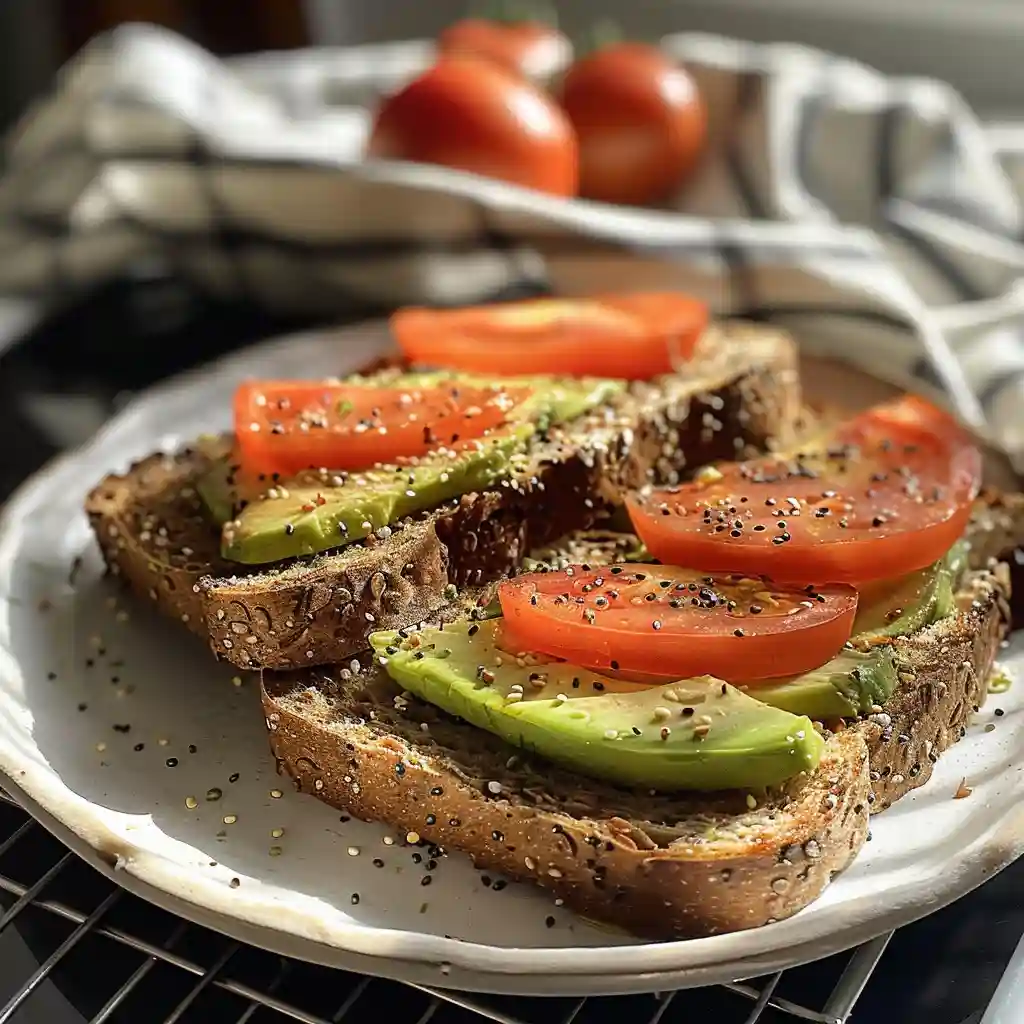
PART 7: Common Mistakes to Avoid When Making Protein Bread
Let me tell you, my first few tries making high protein bread were… rough. One loaf came out dry like cardboard. Another collapsed in the middle. If you’ve had similar kitchen fails, you’re not alone. Here’s what I learned from dozens of test batches—so you don’t have to make the same mistakes.
Why Your Bread Might Turn Out Dry or Dense
Protein is a tricky beast in baking. Too much, and your bread feels like a brick. Too little, and it’s basically a regular loaf with a marketing label.
🔍 Top Dryness/Density Culprits:
- Using too much protein powder
More doesn’t always mean better. Aim for no more than ¼ cup per loaf unless the recipe says otherwise. - Not enough moisture
Protein powders absorb a ton of liquid. Be generous with ingredients like Greek yogurt, eggs, or even unsweetened applesauce. - Skipping the fat
Healthy fats like olive oil, nut butter, or whole eggs keep the crumb tender and prevent dry texture. - Overbaking
Bake until a toothpick comes out just clean. Overbaking zaps moisture fast.
If you’re using alternative flours or experimenting with gluten-free ingredients, check out our keto peanut butter cookies—they use minimal flour and are still soft thanks to healthy fats.
Ingredient Swaps That Work (and Ones That Don’t)
When you’re short on ingredients, it’s tempting to improvise—but not all swaps are safe in protein baking. Here’s what’s worked (and failed) in my kitchen.
| Substitute | Works Well | Avoid If |
|---|---|---|
| Greek Yogurt for Oil | Adds moisture & protein | You’re aiming for a crisp crust |
| Pea Protein for Whey | Vegan-friendly | Recipe relies on whey texture |
| Flax Egg for Egg | Vegan baking | Needs rising structure |
| Almond Flour for Oat Flour | Great in keto recipes | You’re avoiding nuts |
| Coconut Flour | Use very little—absorbs tons of liquid | Replacing 1:1 with any other flour |
One flop I’ll never forget: I swapped coconut flour 1:1 for almond. The result? Dry sponge brick. Lesson learned.
If you’re interested in less common ingredients, our ayurvedic spiced quinoa breakfast bowl uses high-protein grains in sweet dishes without over-relying on powders.
PART 8: How to Incorporate High Protein Bread into Daily Meals
When I switched to high protein bread, I wanted it to be more than just “better toast.” I wanted real fuel—something that fit into my day no matter what was on the schedule. Here’s how I work it into breakfast, lunch, and even snacks with no extra prep or gimmicks.
Meal Prep Ideas for Breakfast, Lunch, and Dinner
🥣 Breakfast: Fast Fuel to Start the Day
- Protein French Toast Meal Prep: Make a batch Sunday, refrigerate or freeze slices.
- PB Banana Power Toast: Smear on peanut butter, top with banana and chia seeds.
- Avocado Egg Smash: Use hard-boiled eggs and mashed avocado over toasted protein bread.
I rotate these weekly. The key is keeping it easy, filling, and blood-sugar stable.
🥪 Lunch: Sandwich Power-Ups
- Turkey & Spinach Wraps: Fold protein bread around turkey, spinach, and hummus.
- Grilled Cheese Upgrade: Use high protein bread and add an egg in the middle.
- Tuna Melt Toast: Quick open-faced toast with Greek yogurt tuna salad.
Need more ideas? Try this high protein artichoke dip spread on warm bread. Add chopped chicken for a lunch that fuels you all afternoon.
🍽️ Dinner: Savory Sides & Creative Mains
- Serve alongside chili, soups, or stews as a protein-rich side
- Make protein-bread grilled sandwiches with melted mozzarella and turkey bacon
- Build mini bread pizzas using our high protein cottage cheese pizza crust
High Protein Pairings: Spreads, Dips, and Sides
High protein bread shines when paired with balanced sides. Here are some of my go-to combos that turn a slice into a full meal:
| Protein Bread Base | What to Add | Why It Works |
|---|---|---|
| Toasted Slice | Cottage cheese + salsa | Balanced savory snack |
| Open-Faced | Almond butter + berries | Sweet, filling, loaded with fiber |
| Croutons | Greek yogurt ranch + raw veggies | Perfect for snack boxes |
| Grilled | Chicken, avocado, tomato | Lunch that won’t leave you starving |
And if you’re like me and love an unexpected dessert moment, our kodiak protein ice cream makes a fun post-dinner pairing with cinnamon protein toast.
PART 9: Tips for Storing and Serving High Protein Bread
Best Storage Methods for Freshness
Homemade or store-bought, high protein bread tends to have a shorter shelf life than commercial loaves. Why? Because it skips the preservatives—and that’s a good thing.
Here’s how I store it to keep every slice fresh:
🥖 Short-Term (1–3 Days)
- Keep it in an airtight container or zip bag at room temperature
- Store in a dark, cool area (but not the fridge—it dries out)
❄️ Mid-Term (Up to 7 Days)
- Refrigerate in a sealed bag with a paper towel to absorb moisture
- Let it come to room temp before serving, or re-toast for best texture
🧊 Long-Term (1–2 Months)
- Slice before freezing, then wrap tightly in parchment and foil or freezer bags
- Toast straight from frozen or defrost on the counter—avoid microwaving
Want something unique to serve with that toasted slice? Don’t miss our high protein artichoke dip. It’s creamy, savory, and built for dunking.
Freezing and Toasting Techniques
Freezing high protein bread is a lifesaver for busy weeks. Here’s what works best in my experience:
🔥 How to Freeze Like a Pro
- Always freeze individual slices, not whole loaves
- Use parchment between slices to prevent sticking
- Store in portioned freezer-safe bags (I label them by date)
🥯 Toasting Tips for Texture
- Use a toaster oven or skillet instead of a microwave—it keeps it crispy
- Add toppings after toasting, not before
- For sandwiches, toast both slices before assembling to keep structure firm
And if you’re packing lunch? Toast the bread lightly, then let it cool before assembling. No soggy sandwiches here.
Try pairing your next batch with our protein fluff guide—a fun, sweet spread for snack boxes or school lunches.
FAQ: High Protein Bread
What bread is the highest in protein?
Typically, homemade high protein bread offers the most (8–12g per slice), but Oroweat Protein and Carbonaut are top store-bought contenders at 7–8g per slice.
Which Dave’s Killer Bread has the most protein?
The Powerseed variety has about 5g per slice, and with all those seeds, it’s packed with nutrients, too.
Is high protein bread a thing?
Absolutely! It’s now widely available in stores and online. From low-carb to sprouted grain options, high protein bread is mainstream and growing in popularity for people wanting more than empty carbs.
Is Ezekiel bread a protein bread?
Yes. Ezekiel 4:9 contains about 5g of complete plant protein per slice thanks to sprouted grains and legumes. It’s naturally high in fiber, too.
Conclusion: Is High Protein Bread Worth It?
For me and my family, switching to high protein bread wasn’t just about macros—it was about feeling better, staying fuller, and making smarter food choices. Whether you’re meal prepping, chasing fitness goals, or simply trying to reduce sugar spikes, this bread can totally change your game.
Start with a good brand or make your own. Add it to your sandwiches, your French toast, even your dessert plates. I promise, once you make the switch, you’ll wonder why you didn’t do it sooner.
Don’t miss our latest healthy recipes and real-life food hacks on Facebook and Pinterest.
